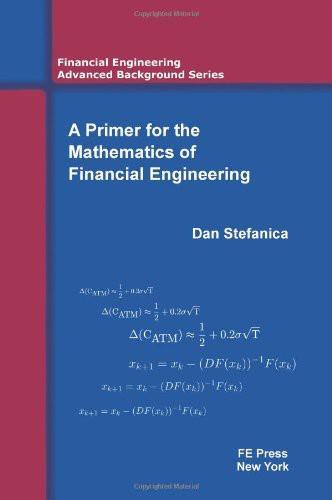
A Primer for the Mathematics of Financial Engineering
by
Dan Stefanica
Published 4 Apr 2008
.- AND r-HEDGING keeps the portfolio close to Delta-neutral, and therefore reduces the risk of losses if the price of the underlying asset changes rapidly, but increases the trading costs), and rebalancing only when the hedge becomes inaccurate enough (which reduces the trading costs but increases the risk of having to manage a portfolio that is close to, but not exactly Delta-neutral, most of the time). To achieve a better hedge of the portfolio, i.e., to have a portfolio that is even less sensitive to small changes in the price of the underlying asset than a Delta-neutral portfolio, we look for a portfolio that is both Delta-neutral and Gamma-neutral, i.e., such that .6.
…
Option Position Hedge Position Sign of Option Delta Short Asset Positive Delta Long Call Long Asset Negative Delta Short Call Long Put Long Asset Negative Delta Short Asset Short Put Positive Delta Note that a portfolio is Delta-neutral only over a short period of time. As the price of the underlying asset changes, the portfolio might become unbalanced, i.e., not Delta-neutral. In this case, the hedge needs to be rebalanced, i.e., units of the underlying asset must be bought or sold in order to make the portfolio Delta-neutral again. Deciding when to rebalance the portfolio is a compromise between rebalancing the hedge often (which Therefore, if a portfolio is Gamma-neutral, its Delta will be rather insensitive to small changes in the price of the underlying asset.
…
., to have a portfolio that is even less sensitive to small changes in the price of the underlying asset than a Delta-neutral portfolio, we look for a portfolio that is both Delta-neutral and Gamma-neutral, i.e., such that .6. (II) av = as' 107 all = as = ° and r(II) a2ll = aS2 = 0, where the Gamma of the portfolio is denoted by r(ll). Note that where S is the spot price of the asset. The value of the new portfolio, II r(II) = a.6.(II) = V - .6.. S, as . will be insensitive to small changes in the price of the underlying asset. Such a portfolio is called Delta-neutral, since all .6.(ll) av = as = as - .6. = 0. Recall that the correct hedging position for a long call is short .6. shares. Therefore, the hedging position for a short call is long .6. shares.
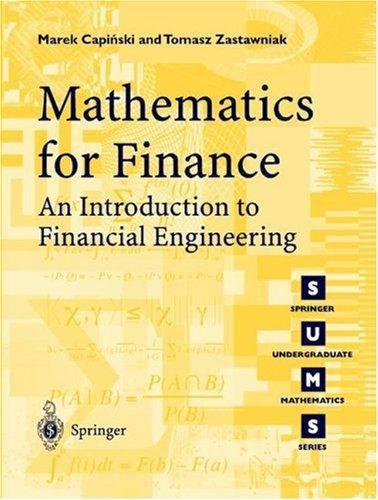
Mathematics for Finance: An Introduction to Financial Engineering
by
Marek Capinski
and
Tomasz Zastawniak
Published 6 Jul 2003
Exercise 9.3 Suppose that 50, 000 puts with exercise date in 90 days and strike price X = 1.80 dollars are written on a stock with current price S(0) = 1.82 dollars and volatility σ = 14%. The risk-free rate is r = 5%. Construct a delta neutral portfolio and compute its value after one day if the stock 1 ) = 1.81 dollars. price drops to S( 365 Going back to our example, let us collect the values V of the delta neutral portfolio for various stock prices after one day as compared to the values U of the unhedged position: S 58.00 58.50 59.00 59.50 60.00 60.50 61.00 61.50 62.00 V −71.35 −31.56 −3.26 13.69 19.45 14.22 −1.77 −28.24 −64.93 U 1, 100.22 849.03 586.35 312.32 27.10 −269.11 −576.07 −893.53 −1, 221.19 196 Mathematics for Finance Now, let us see what happens if the stock price changes are considerable: S 50 55 60 65 70 V −2, 233.19 −554.65 19.45 −481.60 −1, 765.15 U 3, 594.03 2, 362.79 27.10 −3, 383.73 −7, 577.06 If we fear that such large changes might happen, the above hedge is not a satisfactory solution.
…
This gives a total of 33, 914.69 dollars received to be invested at 5%. The value of the delta neutral portfolio consisting of the shored stock, invested cash and sold options will be −32, 332.29 + 33, 914.69 − 1, 582.40 = 0.00 dollars. 296 Mathematics for Finance One day later the shorted shares will be worth 17, 765 × 1.81 = 32, 154.64 dollars, whereas the cash investment will grow to 33, 914.69e0.05/365 ∼ = 33, 919.34 dollars. The put price will increase to 0.035182 dollars, so the price of 50, 000 puts will be 1, 759.11 dollars. The value of the delta neutral portfolio will be −32, 154.64 + 33, 919.34 − 1, 759.11 ∼ = 5.59 dollars. 9.4 The price of a single put after one day will now be 0.038885 dollars, the 50, 000 options sold will therefore be worth 1944.26 dollars, the stock and cash deposit positions remaining as in Solution 9.3.
…
For small price by the derivative dS variations from S to S + ∆S the value of the portfolio will change by d V (S) × ∆S. dS The principle of delta hedging is based on embedding derivative securities in a portfolio, the value of which does not alter too much when S varies. This can be achieved by ensuring that the delta of the portfolio is equal to zero. Such a portfolio is called delta neutral . We take a portfolio composed of stock, bonds and the hedged derivative security, its value given by ∆V (S) ∼ = V (S) = xS + y + zD(S), where the derivative security price is denoted by D(S) and a bond with current value 1 is used. Specifically, suppose that a single derivative security has been 9.
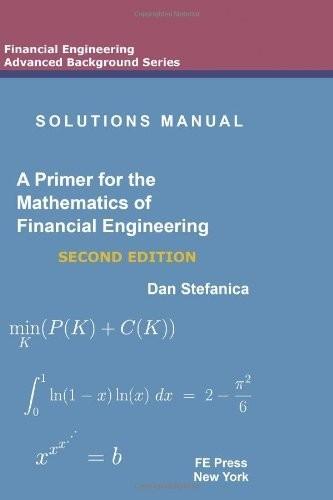
Solutions Manual - a Primer for the Mathematics of Financial Engineering, Second Edition
by
Dan Stefanica
Published 24 Mar 2011
(i) How m时1 is the portfolio worth? (ii) How do you adjust the stock position to make the portfolio Delta-neutral? (iii) A month later , the spot price of the underlying asset is $24. What is new value of your portfolio , and how do you adjust the stock position to make the portfolio Delta-neutral? Solution: (i) The value of the portfolio is 1000P(0) + -803 + 400 = ( 1 \ ( 1\ I + 8038 I 飞 12 ) ~-_ I 飞 12 } 十 1946 = 23400. The new Delta of the portfolio is -1000N( -d l ) + 803 = 292. To make the portfolio Delta-neutral , you should sell 292 shares. 口 Problem 8: You hold a portfolio with i:::.. (II) = 300 , r(II) 工 100 and vega(II) = 89.
…
and the put option7respectively.The value of the zlew portfolio is II旧w=II 十 x 1 8 + X2 C + 句 P and therefore i:::..(丑nω) = i:::.. (II) 十 Xl + x 2 i:::.. (C) 十 x 3 i:::.. (P); r(II nω ) = r(口) + X2 (C) + X3 (P); vega(口new) - vega(II) 十 x2veg a (C) 十 x3 ve g a (P). r r Then , i:::..(丑nω) = r(丑ηω) = vega(II n 叫 = 0 if and only if • (们 0.2X2- 0.8 - 403. To obtain a Delta-neutral portfolio , 403 shares must be purchased for $8 ,060. The Delta-neutral portfolio will be made of a long position in 1000 put options a long position in 803 shares of the underlying stock , and $1 ,940 in cash. (iii) A month later , the spot price of the und 凹lying asset is S ( 古剖) = 24 a丑 the put opt悦ions have 直 fi飞ve months lef 丘t ur时 l垃t挝 削i让1 maturity.
…
Assume that the risk自free rate is constant at 4%. (i) How much is the portfolio worth? (ii) How do you adjust the stock position to make the portfolio Deltaneutral? (iii) A month later , the spot price of the underlying asset is $24. Wr时 is new value of your portfolio , and how do you adjust the stock position to make the portfolio Delta-neutral? Solution: If p is the probability of the coin toss resulting in heads , then the probability of the coin toss resulting in tails is 1 - p. The outcomes of the first two tosses are as follows: • If the first toss is tails , which happens with probability 1 - p , then the process resets and the expected number of tosses increases by 1. • If the 趾st toss is he告ds , and if the second toss is also heads , which happens with probability p气 then two consecutive heads were obtained after two tosses.
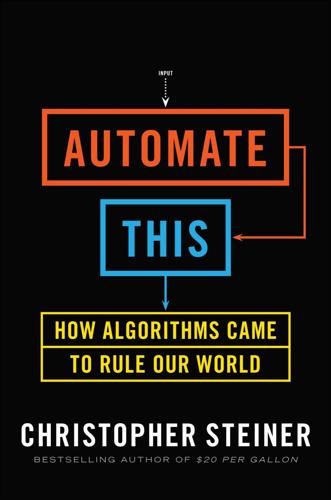
Automate This: How Algorithms Came to Rule Our World
by
Christopher Steiner
Published 29 Aug 2012
First and foremost, the algorithms searched for options that were egregiously mispriced. What Peterffy was especially interested in—and what he wrote his algorithms to search for—were what’s known as delta neutral trades. In these trades, an overpriced call option, which Peterffy would sell, could be coupled with buying an underpriced put option to create a position that wouldn’t be adversely affected by a spike or a dip in the market. For example, say shares of IBM were trading hands at $75. A delta neutral trade for Peterffy could look something like this: He would sell 10,000 call options (the right to buy IBM at a strike price of $75 during the next sixty days) for $1 each (the overpriced option), taking in the $10,000.
…
Because options on stocks of big companies such as IBM traded at dozens of different strike prices as well as multitudes of diverse expirations, the 1980s options market was rife with delta neutral trades for those who could find them. Some floor traders had caught on to the tactic—they scanned the tapes and tickers for mispriced options that could easily be hedged for riskless profits. But the power of a few men searching out trades in the pits was no match for Peterffy’s indefatigable machine. The computer would put together trades that made for delta neutral plays and print them out immediately. Peterffy, confined to a chair with a bum knee, would then place a call to his floor clerk, who would get the trades to his corps of women.
…
Just as with Peterffy’s other traders, Van Peebles frequently ran sorties to a large bank of phones on the trading floor to communicate with Timber Hill’s headquarters. On the phone, he scribbled down a jumble of letters, numbers, and fractions—his instructions. From there, he careened back into one of the roiling pits and put up his hands, ordering fresh delta neutral trades. Van Peebles’s story accentuated the success of the most improbable trading squad roaming the pits of New York, perhaps to this day: three blonde women and one highly acclaimed black writer, director, and actor, all of them well-disguised proxies of an algorithm that dwelled inside a machine.
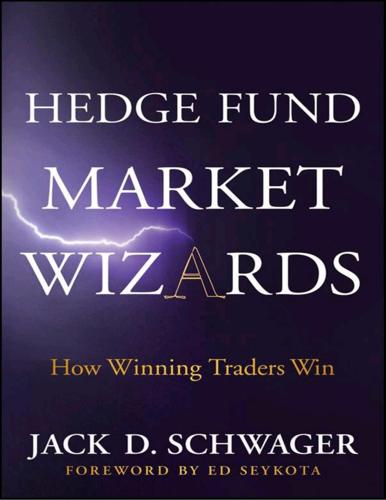
Hedge Fund Market Wizards
by
Jack D. Schwager
Published 24 Apr 2012
There are other systems that have a greater variety of values that may provide modest improvements in either strategy or bet sizing. 9In a static hedge, the warrant position is counterbalanced by an equal delta opposite position in the stock at time of trade implementation, resulting in a delta neutral combined position. (Delta neutral means that the value of the combined position will remain approximately unchanged for small changes in price.) In a dynamic delta hedge, the offsetting stock position is continually adjusted to maintain an approximately delta neutral total position. 10 Delta neutral hedging means that purchases and sales of the underlying stock are used to keep the combined position balanced so that it is approximately unaffected by small price changes in either direction. 11 http://edwardothorp.com/id9.html. 12If this question is intelligible, no explanation is necessary; if it isn’t, any adequate explanation would be far too lengthy and tangential. 13Bruce Kovner is the founder of Caxton Associates, a highly successful global macro fund, and was profiled in my book Market Wizards (New York: Institute of Finance, 1989).
…
Kassouf thought he could tell something about the direction of stock prices and would sometimes take a fundamental view on a stock, whereas I was afraid to do that because I didn’t believe I had any forecasting power. I thought we should always hedge to be delta neutral. 10 So we went our separate ways. He and his brothers started a managed money business, while I managed my individual accounts for a while. When did you develop your own option-pricing model? In 1967, I took some of the ideas about how to price warrants in the Random Character of Stock Prices by Paul Cootner and thought I could derive a formula if I made the simplifying assumption that all investments grew at the risk-free rate. Since the purchase or sale of warrants combined with delta neutral hedging led to a portfolio with very little risk, it seemed very plausible to me that the risk-free assumption would lead to the correct formula.
…
Were you just making the market in the XMI calls or were you also trading a proprietary account? Both. As the specialist you provide liquidity. You also have an inherent advantage in trading because you see the order book. When you fill an order, how do you lay off the risk? If I was a seller of calls, I would buy futures against it. I would keep the book close to delta neutral. So you were essentially making the bid/ask spread and laying off the risk. Yes, but as a specialist, you also have to anticipate. If the market is strong, and you know you will have call buyers all day, you buy futures ahead of that. In other words, you anticipate your hedge needs and adjust your delta.
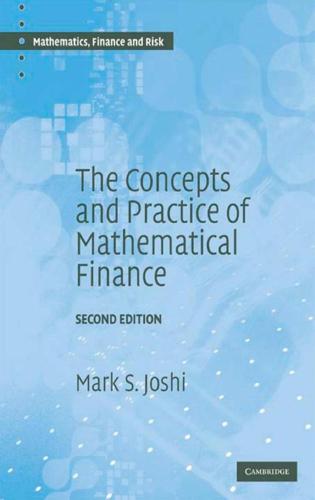
The Concepts and Practice of Mathematical Finance
by
Mark S. Joshi
Published 24 Dec 2003
If we are long Gamma then, over the lifetime of the option, our hedging makes us money realizing the option's value. To see why this is the case, we expand the Taylor series of the portfolio value, P(S, t), as a function of S, we have z P(S + AS, t) = P(S, t) + aS (S, t)AS + 2 aS2 (S, t)OS2 O(OS3). (4.5) If the portfolio is Delta-neutral then the main term is 1 a2p a as2 (s, t)AS2, and thus the stock's price variations up and down will cause money to be lost or gained according to the sign of the Gamma. We saw that as maturity approaches the Delta of a call option behaves more and more like a step function equal to 0 below the strike and 1 above it.
…
Exercise 4.3 If a digital call and a digital put have the same expiry and strike, what relations will their Greeks satisfy? Exercise 4.4 If a derivative has a negative Vega and volatility increases what happens to the price? Exercise 4.5 A portfolio consisting of a short position in a call option and a long position in a stock is Delta-neutral. Suppose the stock price jumps; how will the value of the portfolio change if the option is priced according to the Black-Scholes formula before and after the jump? Exercise 4.6 Derive simple approximations for at-the-money Vega and Theta. Exercise 4.7 Show that call and put options with the same strike and expiry have the same Vega.
…
Suppose we use the vanilla call option, 0, struck at 100 as a hedging instrument and we want to hedge a call option, C, struck at 110. We can set up a hedging portfolio consisting of -1 units of C, and a units of 0 and A stocks, together with bonds to ensure the self-financing condition holds. We want the portfolio's value to be invariant under small changes in S, that is, to be Delta-neutral, and to be invariant under jumps. This means we require a and A to be such that ac a0 - - +a as +0=0, (15.18) and that -C(S, t) + aO(S, t) + AS = -C(JS, t) + aO(JS, t) + AJS, (15.19) 15.7 Matching the market 377 where J is the jump amplitude. We have two equations in two unknowns which we can solve for a and A.
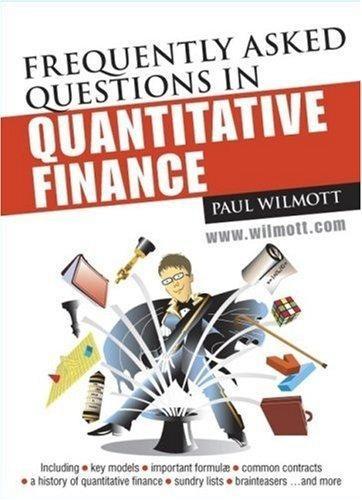
Frequently Asked Questions in Quantitative Finance
by
Paul Wilmott
Published 3 Jan 2007
If they own options then their exposure to the underlying is, to a first approximation, the same as if they own delta of the underlying. Those who are not speculating on direction of the underlying will hedge by buying or selling the underlying, or another option, so that the portfolio delta is zero. By doing this they eliminate market risk. Typically the delta changes as stock price and time change, so to maintain a delta-neutral position the number of assets held requires continual readjustment by purchase or sale of the stock. This is called rehedging or rebalancing the portfolio, and is an example of dynamic hedging. Sometimes going short the stock for hedging purposes requires the borrowing of the stock in the first place.
…
This can be costly, you may have to pay a repo rate, the equivalent of an interest rate, on the amount borrowed. Gamma The gamma, Γ, of an option or a portfolio of options is the second derivative of the position with respect to the underlying: Since gamma is the sensitivity of the delta to the underlying it is a measure of by how much or how often a position must be rehedged in order to maintain a delta-neutral position. If there are costs associated with buying or selling stock, the bid-offer spread, for example, then the larger the gamma the larger the cost or friction caused by dynamic hedging. Because costs can be large and because one wants to reduce exposure to model error it is natural to try to minimize the need to rebalance the portfolio too frequently.
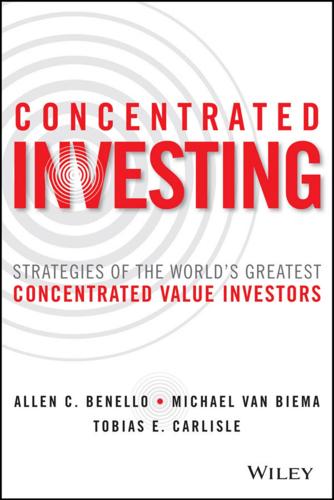
Concentrated Investing
by
Allen C. Benello
Published 7 Dec 2016
Edward Thorp and Applied Kelly Theory In November 1969, Thorp founded what he believed to be the world’s first market‐neutral hedge fund, Convertible Hedge Associates (renamed Â�Princeton‐Newport Partners in 1974).33 The fund used warrants, over‐the‐ counter (OTC) options, convertible bonds, preferred stock, and common stock to construct a delta‐neutral portfolio—one that was unaffected by changes in the underlying common stock. Like Shannon, he too sought to exploit the random walk phenomenon, not through Shannon’s Demon, but through convertible arbitrage. Thorp’s strategy, though it was considerably more sophisticated, shared with Shannon’s Demon the use of constant rebalancing to eke out tiny profits from changes in the prices of matched securities as they reverted to the mean.
…
., 18 Carr, Fred, 10–11, 114 Cassel, Sir Ernest, 42 Central National-Gottesman, 184 Chambers, David, 45, 46, 48, 51, 54–59, 64, 65 Chemical Bank, 132, 133 “Chest Fund” (King’s College, University of Cambridge), 47, 52–54, 53, 59, 61, 62 Chieftain Capital Management, 177–180, 185–186 Chua, Jess, 52–54 Citibank, 145 “closet indexers” defined, 27, 123–124 example, 94–104, 95, 99, 100, 102, 103, 104 Coca-Cola, 23–24, 188 Codex Corporation, 78 Coface, 150 Comcast, 177–180 Common Brothers, 138–142, 143 Common Stocks and Uncommon Profits (Fisher), 116, 215 Common Stocks as Long-Term Investments (Smith), 45 concentrated value investing Buffett on, 94–96, 95 diversification versus, 1–2, 94–104, 95, 99, 100, 102, 103, 104 Greenberg on, 186–194, 194–199 Keynes and, 48, 57–65 (See also Keynes, John Maynard) overview, 1–4 permanent impairment of capital for, 63–64 (See also long-term investment) 225 Index Shannon’s Demon and, 81 Thorp on, 86–87, 104–106 Convertible Hedge Associates, 83 Cook, J. Michael, 177 credit cycle theory of investment, 39, 42, 45 Crown Cork & Seal, 82 Curzon, F. N., 59–60, 212 D Daily Journal Company, 116–117 Damn Right! (Lowe), 120–121, 213 Davidson, Lorimer, 6–7, 26 Davy Shipbuilding, 135–136 De Angelis, Anthony “Tino,” 89–90 delta-neutral portfolio, 83 Den Norske Bank (DnB), 138, 146–147 Diamon M. Dragon (drill ship), 138–142, 143 Dimson, Elroy, 45 diversification Buffett on diversification versus concentration, 94–96, 95, 207–209 “closet indexers,” 27, 94–104, 95, 99, 100, 102, 103, 104, 123–124 diversification versus concentration, overview, 1–2 Graham on, 106 Keynes on, 62 Munger on diversification versus concentration, 96–97 Simpson on, 19, 27–28 Diversified Retailing, 110, 112 Dodd, David, 45 dollar cost averaging Keynes on, 51 Shannon’s Demon and, 80 Dolphin, 137 Drake, George, 159 Drexel Burnham Lambert, 144 DSND Subsea, 151–153 Durbin Amendment (Dodd-Frank), 192 Dutch auction, 22 Dutton, Gardiner, 160 E earnings yield, 19, 49 EBIDTA (earnings before interest, taxes, amortization, and depreciation), 154 Economic Consequences of Peace, The (Keynes), 40, 41 edge/odds, 76, 209–210 Edgewater Funds, 163 efficient market theory Munger on, 121, 207 overview, 3 Effjohn, 142 Elton, E.

Trading Risk: Enhanced Profitability Through Risk Control
by
Kenneth L. Grant
Published 1 Sep 2004
GREEK ALPHABET SOUP I am currently working with an equity options trader who uses options to try to capture short-term trading flows in the equity markets—much in the same way a run-of-the-mill short-term U.S. equity trader would with stocks. Equities have been very volatile lately, and he’s made a particular effort to keep his portfolio neutral in terms of directional market exposures. The standard way of doing this in options-land is to achieve something called delta-neutrality—a condition under which put and call positions (long and short) offset one another in terms of their reaction to moves in underlying markets. He has been quite the zealot about this, and, as such, we were both surprised at how badly he was getting nicked in a recent wicked market rally. On further inspection, we spotted the problem: The options he was holding that had a negative delta (meaning they would tend to move in the direction opposite that of the underlying market—something almost exclusively associated with long puts and short calls) had much higher betas than did his long delta positions (long calls and short puts).
…
See specific types of correlations analysis, 73–78, 168–181 capital utilization, 171–172 with causation, 79 characteristics of, 73 coefficient, 73, 170 defined, 73, 169 holding periods, 175–177 individual trades, 168–170, 179–181 kitchen sink, 78 against market benchmarks, 73–75 net market value, 172–174 number of daily transactions, 170–171 number of positions, 174 portfolio diversification and, 145 risk exposure and, 83–84, 90–91 VaR, 178–179 volatility, 177–179 Credit spreads, 105 Cross-collateralization, 198 Cross correlation analysis, 75–76 Daily net change, 75 Daily transactions, number of, 170–171 Day traders/day trading, 143–144, 170, 176 253 254 Decision-making process, influential factors, 8, 10, 82, 220–221 Delta-neutrality, 153 Derivatives, 56, 134, 148, 235–236, 241 Directional bias, 135–141, 166 Direct market exposure, 92 Discretionary capital, 29 Diversification, 144–146 Dollar investment, individual securities, 160–161 Drawdown, 50, 70–73 netting risk, 129–131 risk exposure and, 120–125, 233 Earnings announcements/releases, 43, 143, 236 Edge, in trading.
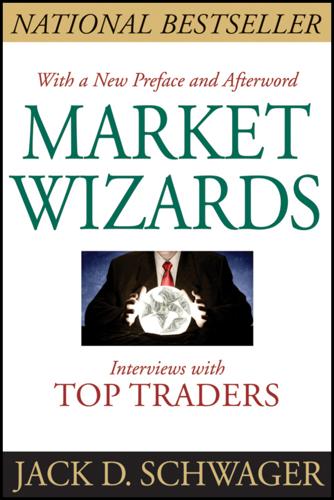
Market Wizards: Interviews With Top Traders
by
Jack D. Schwager
Published 7 Feb 2012
I answered, “We work for a man who has just found himself in the middle of a mine field, and what he did was close his eyes and walk through it. He now thinks that whenever you are in the middle of a mine field, the proper technique is to close your eyes and go forward. Less than one year later, this same man had to liquidate a huge delta neutral spread position in options [a balanced position whose value will change very little for small price moves in either direction]. Instead of just getting out, he decided to get out of the position one leg at a time. By the time he finished liquidating that position, he had gone through all of the firm’s capital.
…
Then I complement that with scalping to help pay for the time decay in the explosion position. In other words, the explosion position is your money bet in case of a big move, while your scalping is paying the bills, that is, the time decay cost of the explosion position. Exactly. Were you always offsetting one position with another? In other words, were you always delta neutral? [An option position in which total equity will remain roughly unchanged for small price changes in either direction.] Usually, but once in a while I would take a significant net position. What was your first really big trade? Teledyne in 1984. The stock had dropped sharply and I was building up a position in the out-of-the-money October calls.

Expected Returns: An Investor's Guide to Harvesting Market Rewards
by
Antti Ilmanen
Published 4 Apr 2011
Absolute return seekers who look for less correlated return sources should prefer variance swaps that largely avoid directional exposure. Variance swap returns are mainly driven by the difference between implied and realized volatilities (squared). However, even though variance swaps are designed to be mathematically delta neutral, they exhibit empirical market directionality (a mild positive equity market beta) because falling equity markets tend to coincide with rising volatility. As noted above, delta-hedged straddles were the best (but noisy) way to buy or sell volatility until variance swap contracts were created and their OTC markets became liquid.
…
Volatility-selling returns are based on the simulated Merrill Lynch Equity Volatility Arbitrage Index since 1989, which tries to gain from the typically positive gap between market-implied volatility and subsequent realized volatility of the S&P 500 index’s Bloomberg ticker MLHFEV1 index. Chapter 15 also analyzes the simulated covered-call-writing indices and put-writing indices (BXM, BXY, PUT in Bloomberg) on the S&P 500 index from the Chicago Board of Exchange, dating back to the 1980s. These indices are not delta neutral so their returns reflect market-directional exposures as much as volatility exposures. Data on volatility-sorted stock portfolios are from Andrew Ang (Columbia University), David Blitz (Robeco), and Giuliano De Rossi (UBS). Importantly, no trading costs have been subtracted from any of the strategy style returns.

Mathematics of the Financial Markets: Financial Instruments and Derivatives Modelling, Valuation and Risk Issues
by
Alain Ruttiens
Published 24 Apr 2013
.); and, more fundamentally, an option replication problem: as a matter of fact (see Sec-tion 12.1.5), despite the credit derivatives are labeled “swaps”, they are actually conditional swaps, that is, options products. Option valuation is based on the ability to build a riskless portfolio, combining some short position in underlying and some long position in a corresponding option. In the case of a credit derivative, it is impossible to take a short position on an underlying default risk, hence, no delta neutral mechanism, and the option theory is not grounded in this case, because such option is not replicable. As a consequence, speculative trading on credit derivatives is actually very different from speculation on most other instruments, because of the absence of a grounded fair or theoretical value to be compared with observed market prices.

Madoff Talks: Uncovering the Untold Story Behind the Most Notorious Ponzi Scheme in History
by
Jim Campbell
Published 26 Apr 2021
This was instituted by the Exchanges in the United States in 2001. * A “box spread” is an options arbitrage strategy that combines buying a bull call spread with a matching bear put spread. The spreads must have the same strike prices and expiration dates so as to be market neutral; this generated a payoff, referred to as a “delta neutral interest rate position.” Sources: Investopedia and Wikipedia. 9 THE ELUSIVE MADOFF King of Wall Street to Inmate 61727054 Bernie Madoff on Madoff: “‘Why on earth did Bernie do it?’ Even Madoff doesn’t know. For that matter, neither did the SEC, and they more than anyone were well aware of the success and accomplishments of my market-making and proprietary trading business.

The Crisis of Crowding: Quant Copycats, Ugly Models, and the New Crash Normal
by
Ludwig B. Chincarini
Published 29 Jul 2012
At the time, many retail investors demanded longer-term insurance protection for their investment portfolios, and thus drove up prices. LTCM traders had many ways to take advantage of their view. Overall, they tried to sell expensive long-term options and then dynamically hedge the unwanted risk with futures and short-term options. In option lingo, they wanted to be delta-neutral: focused only on the idea that equity index volatility would be lower than the level market prices implied, with no exposure to equity market price shifts. If volatility turned out to be lower than implied during the five years after the option changed hands, LTCM made a good profit. LTCM sold options that were priced as if volatility would be as high as 20% per year in the coming years.

Corporate Finance: Theory and Practice
by
Pierre Vernimmen
,
Pascal Quiry
,
Maurizio Dallocchio
,
Yann le Fur
and
Antonio Salvi
Published 16 Oct 2017
All other factors being equal, the closer an option is to being in the money (with maximum time value), the greater the impact of an increase in volatility. While each of the tools presented here is highly useful in and of itself, combining them tells us even more. In practice, it is impossible to create a position that is neutral on all criteria at once. No return is possible when taking no risk. No pain, no gain! Hence, a delta-neutral position and a gamma-negative position must necessarily have a positive theta in order to be profitable. 4. Implied volatility From 1990, the CBOE (Chicago Board Options Exchange) has calculated the VIX, an index of the implied volatility of the Standard & Poor’s 100, using at-the-money options with a maturity shorter than one month.